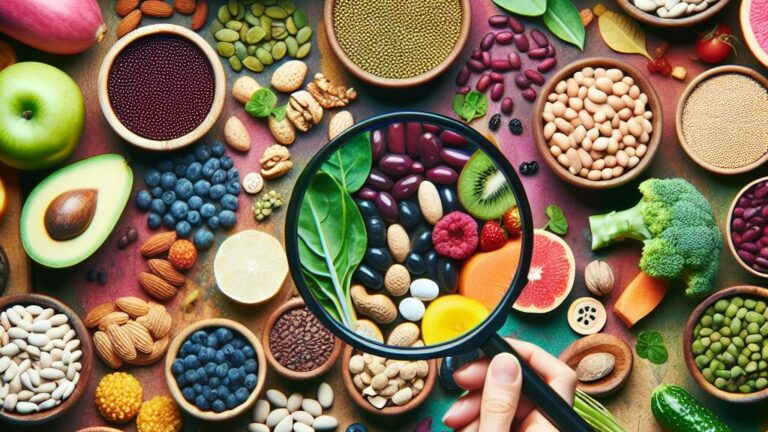How to Transition to a Plant Based Diet
Table Of Contents
How To Transition To A Plant Based Diet | Mastering How to Transition to a Plant-Based Diet: Your Complete Guide to Transitioning to a Healthier Lifestyle
Key Takeaways
- Grasping the Fundamentals of a Plant-Centric Eating Plan
- Getting Ready for the Changeover
- Actions for Shifting to a Plant-Centric Eating Plan
- Organizing Meals and Readiness
- Conquering Obstacles During the Change
- Tools for Ongoing Education
How To Transition To A Plant Based Diet | Understanding the PlantBased Diet
Transitioning to a plant-based diet involves more than just eliminating animal products; it requires a comprehensive understanding of plant-based nutrition and its benefits. A plant-based diet focuses on whole foods, such as fruits, vegetables, grains, legumes, nuts, and seeds, while minimizing processed foods. Embracing a whole food plant-based diet can lead to numerous health advantages, including lowered risk of chronic diseases and improved overall well-being. Learning how to incorporate a variety of plant foods into daily meals is essential for creating balanced, nutritious options. As individuals explore plant-based alternatives, they begin to discover the richness and diversity of flavors within a plant-based lifestyle. Understanding these elements can greatly enhance the experience of those looking to make a successful transition to a plant-based diet.
How to Transition to a Plant Based Diet | Definition and Benefits
A plant-based diet focuses primarily on consuming plants, including fruits, vegetables, grains, nuts, and seeds, while minimizing or eliminating animal products. Understanding how to transition to a plant-based diet involves recognizing the benefits it offers. A well-planned plant-based diet can lead to improved health outcomes, weight management, and a decreased risk of chronic diseases. Dietitians often recommend incorporating a variety of plant-based products, such as legumes and plant-based meat alternatives, to ensure all nutritional needs are met.
Eastern diets are often rich in plant-based foods, showcasing the health benefits associated with this approach. Transitioning from a typical western diet to a healthy diet centered on plants can be a gradual process, allowing time for the body to adapt. Emphasizing ready-to-eat options and easy-to-prepare meals can help make this shift smoother. Consulting a dietician can provide valuable insights and personalized strategies tailored to individual preferences and lifestyle. Understanding how to transition to a plant-based diet is key to reaping its many advantages.
Key Components of a PlantBased Diet
A plant-based diet emphasizes natural foods derived from plants. This approach includes fruits, vegetables, whole grains, legumes, nuts, and seeds. A vegetarian diet can be a stepping stone for those learning how to transition to a plant based diet. Many individuals also consider a flexitarian diet, which allows for occasional consumption of animal products. By incorporating a variety of crops and focusing on leafy greens and green leafy vegetables, one can ensure they receive essential nutrients while enjoying flavorful meals.
Another important aspect of a plant-predominant diet is the balance between different food groups to achieve optimal health. Combining elements from the dash diet can enhance heart health and reduce the risk of chronic conditions. Those fully adopting a vegan diet will eliminate all animal products, while others may opt for a combination of vegetarian diets. Learning how to transition to a plant based diet involves exploring new ingredients and recipes that highlight the diverse flavors and textures of plant-based foods.
Preparing for the Transition
Transitioning to a plant-based diet involves a careful assessment of your current eating habits and setting realistic goals. Understanding how to transition to a plant-based diet requires recognizing the variety of sustainable foods available, including plant-based meats, plant-based cheeses, and plant-based milks. Individuals may also consider incorporating elements from popular plans like dash diets or low carb diets to align their goals with dietary guidelines. As you evaluate your meals, focus on increasing the intake of vegetables and whole grains, such as cereal, while gradually replacing animal products. This preparation phase is essential for fostering a lasting commitment to vegan diets and ensuring a balanced approach to creating nutritious meals.
Assessing Your Current Eating Habits
Understanding your current eating habits is a crucial first step in how to transition to a plant-based diet. Take note of the balance between processed foods and whole foods in your meals. Evaluate the frequency of non-plant-based diets within your weekly routine. This reflection can reveal patterns that may need adjustment as you explore plant-centered diets. Identifying your current dietary preferences will help guide your approach to transitioning to a plant-based diet.
Examining the types of proteins you consume is also important during this diet transition. If soy products dominate your meals, consider how integrating a variety of legumes, nuts, and seeds can broaden your nutritional intake. Plant-predominant diets emphasize diversity in food sources to enhance health. By recognizing your existing eating patterns, including those related to processed foods, you can create a more effective plan for adopting a plant-based eating pattern. Plant-based diet books can offer valuable insights as you refine your goals for a more sustainable diet.
Setting Realistic Goals
Establishing realistic goals is crucial for anyone exploring how to transition to a plant-based diet. Consider starting with small, achievable targets. This could involve incorporating more plant-based meals into your weekly routine or gradually replacing certain animal products with plant-based alternatives. By taking incremental steps, you minimize the overwhelm often associated with diet changes. Focusing on good transition foods, such as legumes, whole grains, and fruits, can ease the shift towards plant-forward eating patterns.
Creating a structured diet plan can help maintain motivation throughout your plant-based journey. Set specific milestones, such as trying a new recipe each week or preparing a comprehensive plant-based meal plan that includes a variety of dishes. This approach not only enhances familiarity with plant food but also builds confidence in your ability to stick with plant-based eating patterns. Tracking progress over time can further encourage adherence to your goals, reinforcing the benefits of your new diet changes.
| Goal | Description | Duration | Tips |
|---|---|---|---|
| Incorporate Plant-Based Meals | Gradually introduce plant-based meals 2-3 times a week. | 1 Month | Start with easy recipes like veggie stir-fries or salads. |
| Replace Animal Products | Swap dairy and meat products with plant-based alternatives. | 2 Months | Experiment with almond milk, tofu, and beans. |
| Try New Recipes | Make it a goal to try a new plant-based recipe each week. | Ongoing | Look for recipes online or join a cooking class. |
| Create a Meal Plan | Develop a comprehensive meal plan that includes diverse dishes. | 1 Month | Utilize meal planning apps to keep things organized. |
Steps to Transitioning to a PlantBased Diet
Transitioning to a plant-based diet involves a thoughtful approach that accommodates your preferences while promoting a nutritious lifestyle. Understanding how to transition to a plant-based diet requires discovering various plant foods that can easily replace animal products in your meals. Exploring diverse plant-based recipes will help you create balanced meals that satisfy your cravings. Incorporating plant-based options like legumes, whole grains, and vegetables will ensure that your diet patterns remain flexible and enjoyable. Experimenting with plant-based snacks can also make the adjustment more manageable. With the right resources and commitment, adopting a plant-based lifestyle becomes an enriching experience that nourishes both body and mind.
| Step | Description | Examples |
|---|---|---|
| 1. Educate Yourself | Learn about the nutritional benefits of a plant-based diet and how to achieve balance. | Books, documentaries, webinars |
| 2. Start Slowly | Gradually replace meat and dairy products with plant-based options, one meal at a time. | Meatless Mondays, plant-based breakfasts |
| 3. Explore Alternatives | Find delicious plant-based substitutes for your favorite animal-based foods. | Tofu, tempeh, plant-based cheese |
| 4. Plan Your Meals | Create a weekly meal plan to ensure you’re eating a variety of foods. | Include legumes, grains, vegetables, and fruits |
| 5. Experiment with Recipes | Try new recipes to discover meal combinations you enjoy. | Chickpea curry, quinoa salads, smoothie bowls |
Gradually Introducing PlantBased Foods
Transitioning to a plant-based diet can begin by incorporating more plant-based options into your meals. Start by replacing one or two meals per week with plant-based recipes. This gradual approach allows you to explore various plant-based food groups without feeling overwhelmed. Plant-based breakfasts can include options like smoothies, oatmeal, or chia seed pudding, while plant-based lunches can feature salads, grain bowls, or wraps. As you experiment with these recipes, you will find what works best for your taste and lifestyle.
As you become comfortable with plant-based cooking, aim to diversify your meals further. Explore different cuisines that naturally emphasize plant-based ingredients to make your diet more enjoyable. Consider visiting local diet places to discover new ingredients or cooking classes tailored for aspiring plant-based eaters. Over time, this new diet can feel less like a challenge and more like an exciting culinary journey. A balanced summary of your efforts will help you see how your diet tends toward healthier habits while embracing the delicious possibilities of plant-based eating.
Finding PlantBased Substitutes
Transitioning to a plant-based diet can be made easier by identifying suitable substitutes for your favorite animal-based products. For instance, if you’re used to enjoying dairy in your morning coffee, consider switching to almond or oat milk. Plant-based vegan options are plentiful and can make your plant-based plate both satisfying and nutritious. Exploring how to transition to a plant-based diet involves understanding which dietary choices align with your preferences while ensuring a varied diet that supports your health goals.
Finding alternatives for meat can also help navigate the plant-based challenge. Seitan, tempeh, and legumes can effectively replace traditional proteins in your meals. Those new to plant-based eating often face a diet struggle, but by embracing various substitutes, it becomes more manageable. Ultimately, the effort you invest in discovering these options will lead to a diet afterward that is diverse and fulfilling, helping you maintain a diet lasting in health benefits and enjoyment.
Meal Planning and Preparation
Planning meals plays a crucial role in understanding how to transition to a plant-based diet. A successful plant-based makeover involves incorporating a variety of whole plant foods and identifying plant-based protein sources that can replace those from your usual diet. Prioritizing plants not only enhances diet benefits but also offers a wealth of nutrients that can support overall health. Creating balanced plant-based meals requires careful consideration of macronutrients, ensuring that the diet doesn’t lack in essential elements. Incorporating close-to-nature foods helps reinforce the plants program, making the transition feel seamless and enjoyable. As you explore plant-based options, remember that meal planning can be achieved overnight with the right strategies in place.
Creating Balanced PlantBased Meals
Balancing your meals is essential when learning how to transition to a plant-based diet. Incorporate a variety of whole foods including fruits, vegetables, whole grains, and legumes to ensure you meet your dietary needs. Good plant protein sources such as lentils, chickpeas, and quinoa can help replace animal-based proteins in your meals. Opting for plant-based swaps, such as using plant-based milk options for dairy and plant-based sauce alternatives instead of traditional condiments, can make a significant difference. Consulting with a dietitian can provide personalized insights into incorporating these ingredients effectively.
Creating a balanced plate also involves ensuring you include all food groups in your meals. Aim to combine plant-based starts like leafy greens or grains with protein-rich foods and healthy fats for optimal nutrition. Plant-based protein powder can be a useful addition to smoothies or oatmeal for those needing extra protein intake. Including a variety of plant compounds found in colorful vegetables not only enhances overall health but also adds essential nutrients. Understanding how to transition to a plant-based diet is an ongoing journey that encourages creativity and exploration in meal planning.
Stocking Your Pantry with Essentials
Transitioning to a plant-based diet requires thoughtful planning, particularly when it comes to stocking your pantry. A well-stocked pantry is essential for a successful nutrition plan that supports your journey. Plant-based folks often agree that having a variety of plant proteins and whole-food diets on hand can make cooking easier and more enjoyable. Consider incorporating staples such as lentils, chickpeas, beans, quinoa, and a selection of nuts and seeds. These plant-based sources contribute to the diet diversity that helps you thrive on your new food choices.
Avoiding common pitfalls during the transition is key to staying committed to a plant-based lifestyle. A pantry filled with colorful fruits, vegetables, and whole grains allows you to experiment with new recipes and flavors. While transitioning to a plant-based diet, it’s important to steer clear of unhealthy processed foods that may undermine your goals. Consulting with plant-based experts can provide further guidance, ensuring that your nutrition journey aligns with your desire to embrace a plant-based forever mentality.
- Stock up on whole grains like brown rice, oats, and barley for nutritious meals.
- Include canned tomatoes and tomato paste for easy base sauces and soups.
- Keep frozen fruits and vegetables on hand for convenient cooking and smoothies.
- Add various spices and herbs to enhance the flavors of your dishes.
- Don’t forget about plant-based oils, such as olive or avocado oil, for cooking and dressing.
- Purchase dairy alternatives like almond milk or coconut yogurt to replace traditional dairy products.
- Ensure you have a selection of condiments, such as soy sauce and nutritional yeast, for added flavor and nutrition.
Overcoming Challenges During the Transition
Transitioning to a plant-based diet can present a variety of challenges that may discourage newcomers. Understanding how to navigate these obstacles is crucial. Many individuals may find it difficult to give up certain foods that are staples in an omnivorous diet, leading to cravings or frustration. Plant-based experts suggest gradually introducing plant sources like a vegetable omelet or a hearty vegetable salad to ease this transition. Engaging with communities on platforms like a diet subreddit can provide support and share salad recipes that make the shift more enjoyable. For those coming from pescatarian diets, exploring diverse options can enhance the experience. Staying committed to this journey requires patience and a willingness to experiment with new flavors and ingredients.
Identifying Common Obstacles
Transitioning to a plant-based diet presents various challenges that individuals may encounter. One common obstacle is the apprehension surrounding new foods and unfamiliar cooking methods. People often struggle with the idea of incorporating red leafy greens and other fresh foods into their meals. Overcoming this hurdle involves educating oneself on high-quality plant proteins and exploring diverse vegan breakfast options. Understanding how to seamlessly blend these elements into daily routines can ease the transition.
Another significant barrier is the tendency to default to established eating habits. Familiar foods can be comforting, making it difficult to embrace a new lifestyle. This can create a mental resistance when trying to add greens and experiment with possible ingredients. To combat this, individuals can seek resources that focus on environmental nutrition, helping them grasp the benefits of a plant-based set of choices. Engaging with a clinic diet or exploring practical diet FAQ can provide valuable insights and support during the transition process.
Strategies to Stay Committed
Staying committed to a plant-based diet requires a strategic approach to your eating pattern. Explore various vegan meal plans that incorporate natural ingredients, emphasizing whole foods. Experimenting with vegetarian recipes can keep meals exciting; try creating vegetable kabobs or a vegan blueberry dessert using minimal refined ingredients. Engaging with diet documentaries can also provide motivation and inspire new culinary ideas while reinforcing your commitment to healthier choices.
Establish a routine that includes meal prepping and planning to keep your favorite foods within reach. Consider integrating items like soy-based products for protein and variety in your diet. A well-rounded summary of your weekly meals can help you stay on track. Regularly revisiting the benefits of this lifestyle can reinforce your goals, making it easier to navigate through challenges as you learn how to transition to a plant-based diet effectively.
- Set specific, achievable goals for your plant-based diet.
- Keep a food journal to track your meals and reflect on your progress.
- Join a community or online group focused on plant-based living for support.
- Experiment with new ingredients and cooking techniques to keep meals interesting.
- Allow yourself occasional treats to prevent feelings of deprivation.
- Stay informed about the nutritional aspects of a vegan diet to ensure your health needs are met.
- Celebrate your successes, no matter how small, to stay motivated.
Resources for Continued Learning
Exploring various resources can significantly enhance your journey on how to transition to a plant based diet. Engaging with wfpb diets offers diverse meal plans that focus on fresh vegetables, organic soy, and nut-based ingredients. Delicious vegan alternatives, including store-bought plant milks and cereal bars, can support your daily nutrition while making the switch. Plant-based athletes often share their experiences and insights, providing inspiration and practical tips for incorporating more plant-friendly options into your meals. Discovering local plant-friendly restaurants can also enrich your dining experiences, helping you to enjoy the best of what a wfpb diet has to offer as you reduce your intake of animal-based foods.
Conclusion
Transitioning to a plant-based diet is a rewarding journey that opens up a world of flavors and health benefits. Understanding how to transition to a plant-based diet involves incorporating many foods that nourish the body, such as organic soybeans and plant-based chicken substitutes. Embracing this eating journey means learning how to create meals with a variety of ingredients that enable the body to absorb nutrients effectively. By exploring nutrition doctrines and focusing on making your own food, you create a sustainable lifestyle that can enhance overall well-being. As you navigate this path, remember that each step brings opportunities to discover delicious alternatives and enrich your diet.
FAQS
What are the key steps in how to transition to a plant-based diet effectively?
Transitioning to a plant-based diet involves several key steps. Start by incorporating more whole foods plant-based diet options into your meals, such as fruits, vegetables, whole grains, and legumes. As you explore plant-based dietary patterns, create plant-based meal plans that feature your favourite foods and prioritize plants. It can be helpful to adopt a flexible diet approach, allowing yourself to occasionally enjoy non-vegetarian diets as you adjust. Additionally, seek out plant-based recipes that suit your taste and lifestyle, and consider meal prepping ready-to-eat options for busy days. Remember, diet diversity equals more nutrition, so try to include a variety of foods in your plant-forward diets. Finally, stay informed by watching diet documentaries and seeking advice from plant-based experts—this will support your journey in transitioning to a plant-based diet successfully.
What are some tips for effectively transitioning to a plant-based diet and ensuring that your diet includes a variety of ready to eat and nutritious plant-based choices?
When transitioning to a plant-based diet, it’s important to focus on a variety of ready to eat options that can make your diet work effectively. Incorporating a range of diet recipes is essential for a smooth transition. In summary, a plant-based diet prioritizes plants and can include typical plant-based foods that are beneficial. To help with plant-based mornings, consider meal prepping your diet overnight and including foods that meet the diet definition of being fully plant-based. Remember, attempting a plant-based aims may require you to eliminate animal-based diet foods, so always check the diet documentary for guidance. Following expert advice on plant-based diets can help ensure that your choices align with environmental nutrition.
What will help you understand how to make the transition to a plant-based diet and why plant-based choices matter?
To understand how to transition to a plant-based diet, it’s important to gain insight from plant-based experts—are they suggesting that your diet should include only plants? A summary of plant-based diets reveals that following foods in a healthful manner can significantly enhance your everyday meals. The American diet can shift towards more environmental nutrition when incorporating whole-foods as part of a plant-based overnight transformation. Remember, it doesn’t matter how much you change your diet; what truly matters is that all components work together, ensuring your new plant-based choices provide abundant nutrition.
How can I get a summary of plant-based diets and why they matter when transitioning my diet to focus on whole-foods?
A summary of plant-based diets indicates that they should emphasize whole-foods and nutritious options, ensuring your diet includes a variety of foods that are healthy and environmentally sustainable. Understanding why plant-based choices matter can enhance your commitment to this dietary shift, particularly in the context of environmental nutrition.
Can you provide a summary of plant-based diets and explain why the choices I make in my diet matter for both health and the environment?
A summary of plant-based diets highlights their focus on whole-foods and the diversity of nutritious options available. Choosing a plant-based diet matters for health as it can reduce the risk of chronic diseases, and it also has significant environmental benefits. When you transition to a diet that emphasizes alpha foods and minimizes animal products, you not only improve your diet but also support environmental nutrition.
When looking for a summary of plant-based diets, how do they align with environmental nutrition and the whole-foods approach?
A summary of plant-based diets highlights their focus on whole-foods and the importance of making choices that are beneficial for both health and the environment. It’s essential to understand how a plant-based diet shouldn’t be seen as restrictive but rather as an opportunity to explore a variety of nutrient-dense foods that contribute positively to environmental nutrition.
When can I find a summary of plant-based diets that includes how they relate to environmental nutrition and the whole-foods approach?
You can find a summary of plant-based diets, which also discusses their significance in environmental nutrition, by researching reputable health and nutrition websites or guides. These resources provide a thorough overview, explaining how a plant-based approach aligns with the whole-foods philosophy and emphasizes sustainable food choices.
When can I access a detailed summary of plant-based diets that highlights the importance of environmental nutrition and how they relate to the whole-foods approach?
You can access a detailed summary of plant-based diets at various health and nutrition websites or through books that cover environmental nutrition. It typically discusses the benefits of plant-based diets, when to make the switch, and how these diets fit within the framework of the whole-foods approach.
When should I look for a summary of plant-based diets that focuses on environmental nutrition and how they relate to the whole-foods approach?
You should seek a summary of plant-based diets that includes their relationship with environmental nutrition when you are preparing to transition your eating habits or when you want to understand the importance of the whole-foods approach in your diet. A good summary of plant-based diets will help clarify these connections and provide guidance on making healthier choices.
When should I seek a summary of plant-based diets to understand their relation to environmental nutrition and the whole-foods approach?
You should seek a summary of plant-based diets when you are looking to explore how these diets can contribute to environmental nutrition, as well as how they relate to the whole-foods approach. A comprehensive summary will provide insights on the benefits of adopting plant-based choices for your health and the planet.







